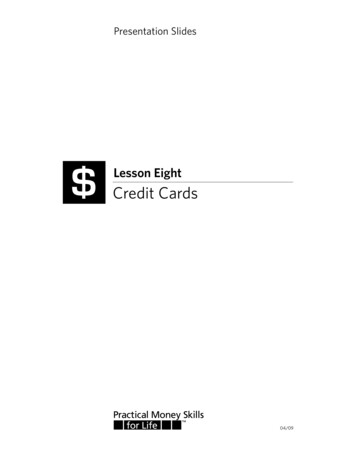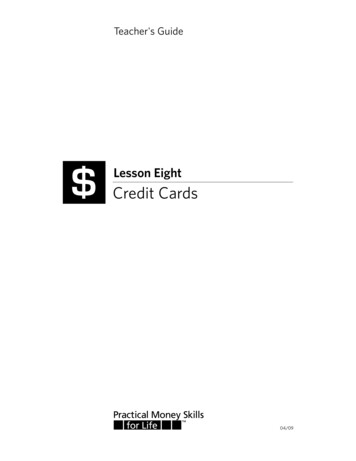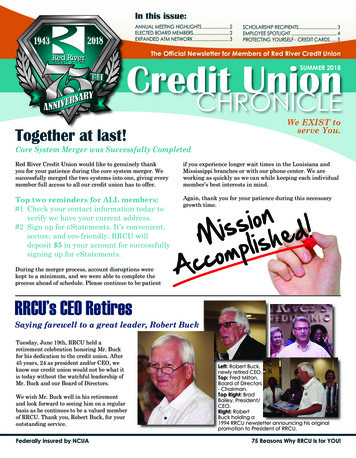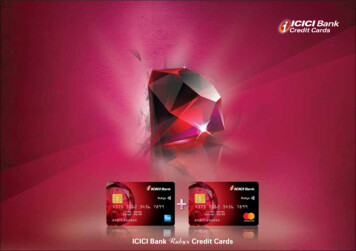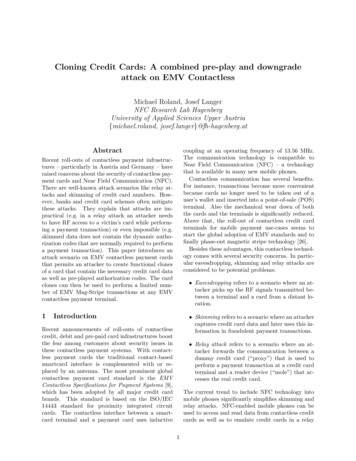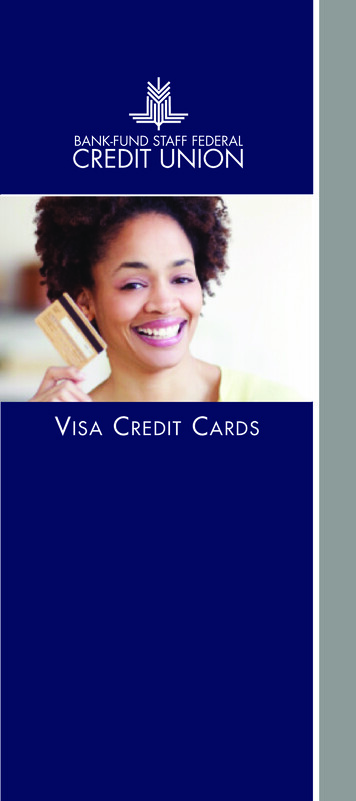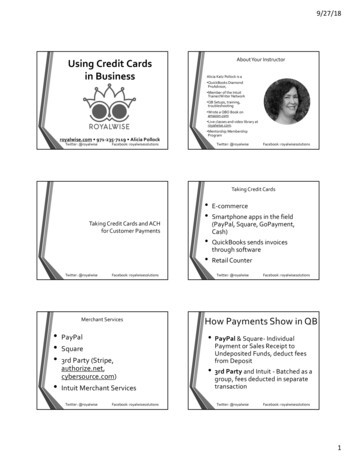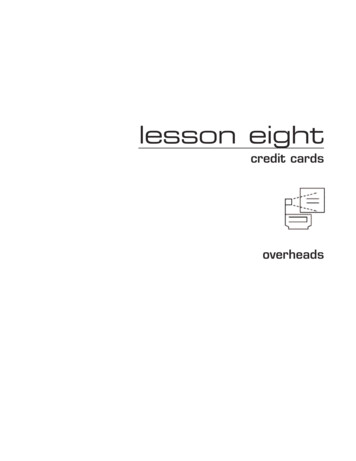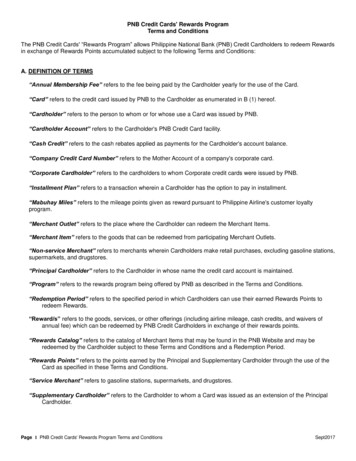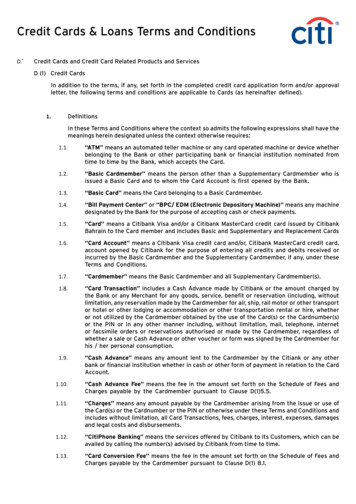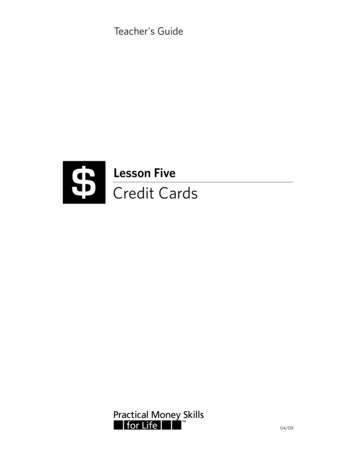
Transcription
Teacher's Guide Lesson FiveCredit Cards04/09
credit cards websitesBefore students use credit cards, it's important that they familiarize themselveswith: the advantages and disadvantages of credit cards; card options andpercentage rates; as well as the true cost of credit.For related links and resources on this lesson, calmoneyskills.com credit cardsteacher's guide 5-i
credit cards lesson outlineoverviewWhat is APR? What is a grace period? What are transaction fees?These and other questions will be answered in this lesson as students learn about credit cards,and the different types of cards available and features of each, such as bank cards, store cards,and travel and entertainment cards.As students start to shop for their first (or next) credit card, this lesson will make them aware ofvarious costs and features. Included in this section is a discussion of the methods for calculatingfinance charges.Various federal laws protect our rights as we apply for and use credit cards, such as proceduresfor disputes and protection from card theft and fraud. In this lesson, students will also be givenan opportunity to analyze the information contained on a credit card statement.To assist students with making wise decisions related to credit cards, several shopping tips areoffered. Finally, once again, students are reminded of guidelines related to determiningsafe debt loads.goals Develop skills to compare and evaluate the terms and conditions of various credit cards, thedifferences between credit cards, and the legal and financial responsibilities involved.lesson objectives List three types of credit card accounts, and explain the uses and payment methods of each Understand how to shop for a credit card Read and interpret a credit card statement Understand how to deal with billing errors Understand the long-term results of overextending your credit uses Determine safe personal debt loadspresentation slides5-Aapplying for a credit card5-Bcalculating finance charges5-Cexamples of finance charges5-Dcomparing credit cards5-Ewhat to do if you’re denied credit5-Freading a credit card statementwww.practicalmoneyskills.com credit cardsteacher's guide 5-ii
credit cards lesson outline5-Gdealing with billing errors5-Hother credit card protections5-Icredit card dos and don’ts5-Jhow much can you afford? (the 20-10 rule)student activities5-1Shopping for Credit 5-2 Students can take a close look at a credit card statement and see what kind ofinformation it contains. Using the credit card statement provided, have students answer the questions attachedto the statement. Have students calculate the total cost of items bought on credit and what the eventualcost of those items will be if only the minimum payment is made and interest chargesaccrue. Have students answer the questions. Discuss their answers. Was anyone surprised attheir answers? Would they have made different choices about buying the items? This can be a good time to talk about values, needs versus wants, budgeting, andthe pros and cons of using credit.How Deep Can They Go? 5-5 When all the teams have finished their research and completed the questions, haveeach team explain to the class how they determined which credit card they wouldrecommend for purchasing the electronic device (question 9). Have the classcritique the logic each team used to arrive at their decision.How Much Does It Really Cost? 5-4 Using the form provided, ask teams of students to shop for three credit cards (twomajor credit cards and one from a local department store). When they’ve finishedtheir research, ask them to answer a series of questions about their findings.What Does Your Statement Tell You? 5-3 Discuss how costs and features can vary between credit cards, and have studentsapply their findings by making a decision about which kind of card they would useto purchase a popular electronic device. Students determine safe debt loads for several consumers. Have students answer the questions and document how they arrived at each answer.When they’re done, review the answers and the formulas used.Lesson Five QuizFor more information, please refer to the Appendix.www.practicalmoneyskills.com credit cardsteacher's guide 5-iii
credit cards target audiencesLearning activities appropriate to varied target audiences for lesson fiveactivityteenagers(14-18)young adults(19-25)adults(26 )Web ActivityCD-ROM ActivityStudent Activity 5-1Student Activity 5-2Class SpeakerWritten PresentationStudent Activity 5-3Student Activity 5-4Lesson Five Quiz 5-5www.practicalmoneyskills.com credit cardsteacher's guide 5-iv
credit cards teaching notestypes of credit card accounts1.Bank card 2.Examples (Visa, MasterCard)Best use ofSample cost/method of paymentStore card 3.discussionExamples (Macy's, Chevron)Best use ofSample cost/method of paymentTravel and entertainment card Examples (American Express)Best use of Sample cost/method of payment shopping for a credit card1. Determining the best use of a card as a personal moneymanagement device Pay bill in full each month and avoidinterest charges Repay bill over time and pay interest charges 2.Annual Percentage Rate (APR)Grace period Annual fee Late payment fee Over-limit fee Balancing computation method for finance charge Credit limit How widely card is accepted What services and features are availableCalculating finance charges (APR) 4.Have students obtaincurrent credit card ratesat bankrate.com(or other websites).Costs and features of credit cards 3.web activity:slides 5-A, 5-B, 5-C,5-D & 5-EAverage daily balanceAdjusted balancePrevious balancePast due balanceExamplesComparing the costs and features of credit cardswww.practicalmoneyskills.com credit cardsteacher's guide 5-v
credit cards teaching notesshopping for a credit card (continued)5.Reading a credit application Interpreting features and costs Examples6.Before signing 7. Know the details of the contractAsk, if you are not sureCompare costs and featuresWhat did you find?What to do if you're denied creditreading a credit card statement1.What it looks like2.How to read onedealing with billing errors1.Fair Credit Billing Act2.student activity 5-1Shopping for a credit card 8.discussionstudent activity 5-2slide 5-Fslide 5-GSteps to takewww.practicalmoneyskills.com credit cardsteacher's guide 5-vi
credit cards teaching notesother credit card protections1.Prompt credit reporting 2. If requested, card issuer must send refund withinseven business days of receiving your request.Unauthorized charges 4. If you are the victim of identity theft or cardfraud, you will typically not be held responsible forthe charges under the card's zero-liability program.Disputes about merchandise or services In some circumstances, you have the right todispute payment for merchandise or services.how you can protect yourself1.slide 5-HRefunds of credit balances 3. Your account must be credited on the day yourpayment is received.discussiondiscussionKeep records of:Card number Phone number to call if card is lost or stolen Until bill arrives, receipts for purchases and returns Receipts for merchandise ordered that has not yetarrived but appears on your bill Record of telephone orders and confirmationnumbers 2.Protect yourself against fraudclass speaker:Have a security personfrom a financial institutionor a law enforcement officialtalk to class about creditcard fraud and theft. When using your card, keep your card in sight. Never give card number over the phone if you didnot initiate the call. Report lost or stolen cards immediately. Carefully read the bills before paying. Compareamount on receipts to amounts on bill. Don’talways assume the bill is correct. Keep receipts; shred when not needed. Destroy unused credit card solicitations. Shop only on secure websites. Don't write down your pin and carry it withyour card. www.practicalmoneyskills.com credit cardsteacher's guide 5-vii
credit cards teaching notessummary of credit card dos and don’ts1.Shop around.2.Look at various sources.3.Read the contract carefully.4.Don’t rush into signing anything.5.Once signed, get copy of contract.6.Know the penalties for missed payments.7.Figure out total price when paying with credit.8.Pay bills in full or at least make the largest paymentsyou comfortably can.discussionslide 5-I9. Don’t be misled into thinking small paymentswill be easy.advantages of using credit cards1.Ability to obtain needed items2.Use of card builds credit history3.Quick source of funds in an emergency4.No extra charge if bill is paid in full each month5.Consumer protectiondisadvantages of using credit cards1. Credit cards are loans that charge interest if not paidin full2. Fees might be charged for late payments or goingover spending3.Can encourage impulse buying and unnecessarypurchases4.Need to establish creditworthiness before getting cardwww.practicalmoneyskills.com credit cardsdiscussiondiscussionwritten presentation:Have students create anewsletter, blog orwebsite with suggestionsfor selecting and using acredit card. Thispresentation can includewebsites and linksavailable to obtain cardinformation.teacher's guide 5-viii
credit cards teaching noteshow much does it really cost?1. How to calculate the total cost of an item bought oncredit and paid for over time with interest2.Exercisesdetermining maximum credit load1.Explaining the 20-10 rule of limiting debt2.student activity 5-3student activity 5-4slide 5-JExerciseslesson five quizwww.practicalmoneyskills.com credit cardsquiz 5-5teacher's guide 5-ix
what does your statement tell you?answer keyA credit card statement provides information such as how and when you’ve used your credit card,how much you owe, how much interest you’re paying to use the card, how much your minimumpayment is, and how much credit you have left.Knowing how to read your credit card statement can also help you catch unauthorized chargesand/or billing errors.So, it can pay to know how to read the statement!directionsUse the credit card statement below to answer these questions:1. What is the date of the statement? 2/13/082. What is the Annual Percentage Rate (APR)? 19.8%3. What is the corresponding periodic rate? 1.65%4. What is the new balance? 125.245. What was the previous balance? 168.806. How many charges were made during the billing cycle? Five7. How many credits and payments were made during the billing cycle? One8. Were there any charges for late payments? NoIf so, how much were the charges? None9. What is the total amount of the credit line? 1,20010. What is the total amount of available credit? 1,074.7611. What is the total amount of charges made during the current billing period? 125.2412. Was there a finance charge for the current billing cycle? NoIf so, how much were the charges? None13. What is the account number on the statement? 4125-239-41214. Where should the payment be sent? Box 1234, Anytown, USA15. What is the periodic rate for cash advances? 0.54%www.practicalmoneyskills.com credit cardsstudent activity key 5-2
how much does it really cost?answer keydirectionsUse the Cost of Credit calculator at practicalmoneyskills.com to answer the following questions.questionsJosé wants to buy a stereo for 650 and pay for it using a credit card that has an Annual PercentageRate of 19.85%.If José pays the minimum monthly payment of 21.45:1. How long will it take him to pay for the stereo? 43 months2. What is the total amount José will pay for the stereo? 909.543. What is José’s total cost of using credit? 259.54If José makes monthly payments of 60:4. How many months will it take for José to pay off the stereo? 13 months5. What is the total amount José will pay for the stereo? 722.206. What is José’s total cost of using credit? 72.20Patty took a cash advance of 1,500. Her new credit card charges an Annual Percentage Rate of 21%. Thetransaction fee for cash advances is 3% of the cash advance, with a maximum fee of 35. This fee is addedto the total cash advance, and accrues interest.If Patty makes monthly payments of 65:7. How long will it take Patty to pay for the cash advance? 31 months*8. What is the total amount Patty will end up paying for the cash advance? 1,997.709. How much interest and fees will Patty pay? 497If Patty pays the cash advance back at a rate of 130 per month:10. How long will it take Patty to pay for the cash advance? 14 months*11. What is the total amount Patty will end up paying for the cash advance? 1,734.5012. How much interest and fees will Patty pay? 234.50*Based on a total advance of 1,535 ( 1,500 35 transaction fee).www.practicalmoneyskills.com credit cardsstudent activity key 5-3
how much does it really cost? answer keyMarie just used her new credit card to buy a bike for 400. Her budget allows her to pay no more than 25 each month on her credit card. Marie has decided not to use the credit card again until the bike ispaid off. The credit card she used has an Annual Percentage Rate of 21%.If Marie pays 25 each month on her credit card:13. How long will it take Marie to pay for the bike? 19 months14. What is the total amount Marie will end up paying for the bike? 473.39*15. How much interest will Marie pay for using her credit card to buy the bike? 73.39*If Marie pays the minimum payment of 14 each month:16. How long will it take Marie to pay for the bike? 40 months17. What is the total amount Marie will end up paying for the bike? 559.3618. How much interest will Marie pay for using her credit card to buy the bike? 159.36Gary has just used his credit card to buy a new watch. He got the watch on sale for 235. The regular pricewas 290. He used a credit card that has an Annual Percentage Rate of 20%.If Gary makes the minimum monthly payment each month of 10:19. How much will Gary end up paying for his new watch? 300.70*20. How long will it take Gary to pay for his watch? 31 months21. What is the total amount of interest Gary will end up paying? 65.70*If Gary pays 25 each month, instead of the minimum monthly payment of 10each month:22. How much will Gary end up paying for his new watch? 257.71*23. How long will it take Gary to pay for his watch? 11 months24. What is the total amount of interest Gary will end up paying? 22.71** Note: These answers are due to approximate rounding.www.practicalmoneyskills.com credit cardsstudent activity key 5-3
how deep can they go?answer keydirectionsRead each of the following scenarios and determine if the purchase can be made and how thedecision will affect the credit load.Write your answers in the blanks provided. Use the space below each problem to show how youarrived at your answer. (Use the other side of this paper if you need more room.)1. Nancy and Thomas have a combined monthly net income of 1,200.What is the most they can afford to pay for installment and credit card debt? 120.00 1,200 x 10% 1202. Jessie has a monthly net income of 800. His fixed monthly expenses consist of 150 for rent.He currently pays 80 each month for a credit card bill, and now he wants to buy a car.What does Jessie have left in his budget for a car payment to stay within his safe debt load? 0 800 x 10% 80 80 - 80 03. Carla has a monthly net income of 450. She wants to buy a new bike and pay for it using acredit card. What is the largest monthly payment she can commit to making? 45 450 x 10% 454. Jorge has a monthly net income of 640. His fixed monthly expense consists of a rent paymentof 120. (A) Right now, how much can he afford to borrow to stay within his safe debt load?He also has a car payment of 125 per month. Jorge wants to buy new tires for his car. The tireswill cost him 40 each month on his credit card.(B) With his car payment and the new tires, will he still be within his safe debt load?(C) What percentage of his net income, after rent, will he now have committed to debtpayments?(A) 640 x 12 7,680(B) 640 x 10% 64 165 / 640 26% 7,680 x 20% 1,536 125 40 165(C) 26%No - 26% is over safe debt load.www.practicalmoneyskills.com credit cardsstudent activity key 5-4
lesson five quiz: credit cardsanswer keytrue-falsetA proprietary credit card is usually accepted by one type of store or company.1. f2. The average daily balance method of calculating interest is based on the openingbalance of the account for the previous month.f3.The annual fee for a credit card is set by the government.4.t5.tAPR measures the interest rate charged by a credit card.If someone uses your lost or stolen credit card, you are liable for no more than 50.multiple choiceAA credit card issued through6. a credit union would be anexample of a card.A. bankB. travel and entertainmentC. storeD. proprietaryB7. The grace period refers tothe time:A. taken to process a creditcard applicationB. for paying an account withoutan interest chargeC. allowed to notify a creditor ofa billing errorD. used for calculating interestC Comparing the APR among several8. credit cards allows you to obtain the:A. lowest grace periodB. lowest annual feeC. lowest interest rateD. least expensive method ofcalculating interestB If a billing error occurs on a credit9. statement, a consumer has daysto notify the creditor.A. 30B. 60C. 90D. 120case applicationJack uses his credit card for almost all purchases. He charges gas purchases, clothing, food, andother living expenses. What is your opinion of this money management habit? If Jack pays off hisbalances each month, his use of credit cards may be a convenient money management technique thatprovides complete records of all of his spending. However, if this habit results in overspending and payingmore, due to interest, Jack needs to assess his financial activities.www.practicalmoneyskills.com credit cardsquiz key 5-5
credit cards lesson outline www.practicalmoneyskills.com credit cards teacher's guide 5-iii 5-G dealing with billing errors 5-H other credit card protections 5-I credit card dos and don’ts 5-J how much can you afford? (the 20-10 rule) student activities 5-1 Shopping for Credit Discuss how costs and feat
